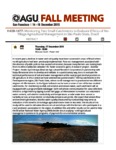Please use this identifier to cite or link to this item:
http://www.alice.cnptia.embrapa.br/alice/handle/doc/1037582| Title: | Monitoring two small catchments to evaluate effects of no-tillage agricultural management in São Paulo state, Brazil. |
| Authors: | FIGUEIREDO, R. de O.  GONCALVES, A. O.   MELO, A. da S.   BONA, F. D. de   HERNANI, L. C.   |
| Affiliation: | RICARDO DE OLIVEIRA FIGUEIREDO, CNPMA; ALEXANDRE ORTEGA GONCALVES, CNPS; ADOILDO DA SILVA MELO, CNPS; FABIANO DANIEL DE BONA, CNPT; LUIS CARLOS HERNANI, CNPS. |
| Date Issued: | 2015 |
| Citation: | In: 2015 AGU FALL MEETING, 2015, San Francisco. E-posters... San Francisco: 2015. Ref. H43B-1477. |
| Description: | In recent years, declines in water and soil quality have been observed in areas of Brazil where no-till agriculture had been previously implemented. Poor soil management associated with the absence of public policies has caused soil erosion, because many farmers are moving back from no-till to traditional cultivation for faster economic gains. A research project ? SoloVivo Project - leaded by Embrapa (Brazilian Agricultural Research Corporation) in partnership with Itaipu Binacional aims to develop and validate, in a participatory way, tools to evaluate the technical performance of soil and water management at the rural properties that practice notill agriculture. In this context we have selected two paired small (< 100 ha) catchments in the Paranapanema region, São Paulo State, where no-till management is practiced at two different degrees of effectiveness. In the figure bellow it can be seen a scene of one of the two studied catchments. For monitoring rainfall, soil solution and stream water, each catchment will be equipped with a programmable datalogger (with cell phone communication for data collection) linked to: a high intensity tipping bucket rain gage; a reflectometer to monitor soil volumetric water content, bulk electric conductivity and temperature; a radar water level sensor; a turbidity sensor; and an electric conductivity-temperature probe. We expect that stream flow and sediment generation, besides water quality (measured by conductivity) may serve as indicators of the benefits of no-tillage agriculture done more or less well. The results of this study will be used to stimulate discussions at workshops with the farmers who participate in a rural producers association in the region. In addition this and other results can be used to help the Brazilian National Water Agency (ANA) decide about applying no-till agricultural management systems in its programs of payment for environmental services. |
| NAL Thesaurus: | Watersheds |
| Type of Material: | Resumo em anais e proceedings |
| Access: | openAccess |
| Appears in Collections: | Resumo em anais de congresso (CNPMA)  |
Files in This Item:
| File | Description | Size | Format | |
|---|---|---|---|---|
| 2015RA029.pdf | 864.12 kB | Adobe PDF |  View/Open |









